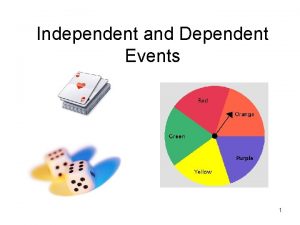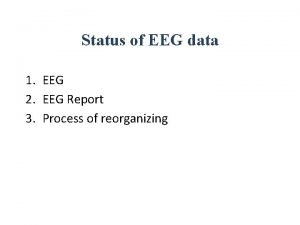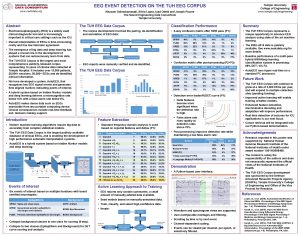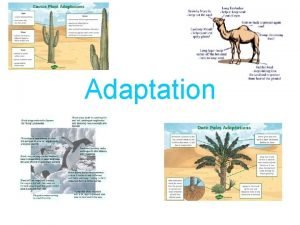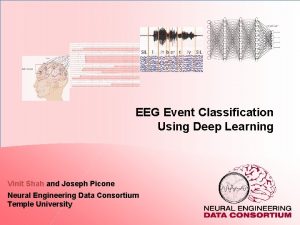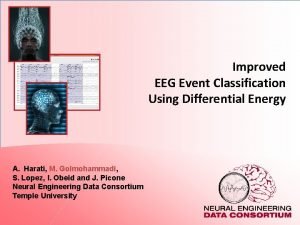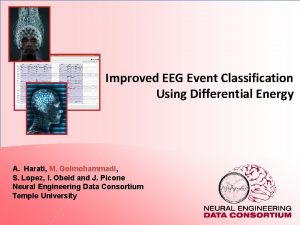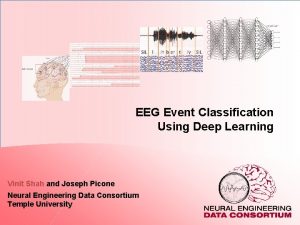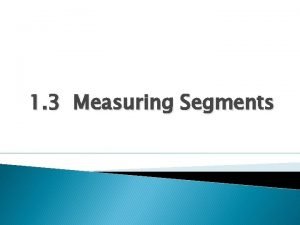Kaldi Adaptation for EEG event classification EEG Segments
















- Slides: 16

Kaldi Adaptation for EEG event classification EEG Segments Vinit Shah & Joseph Picone Neural Engineering Data Consortium Temple University

Outline • Introduction to EEGs and various seizure morphologies • Seizure data and feature extraction • Comparison between Kaldi and Auto. EEG models • Performance of the DNN systems • Error analysis on results V. Shah: Adaptation of Kaldi for EEGs November 13, 2018 2

What is an EEG ? • Electroencephalography (EEG) is a popular tool used to diagnose brain related illnesses. • Scalp Electroencephalogram (EEG) monitoring is a non-invasive and convenient method to assess electrical activity from brain. • Interpretation of EEGs is challenging, and its accurate annotation requires extensive training • Diagnosis is performed considering the factors such as patient’s record video, history, age, environmental & physiological changes, etc. V. Shah: Adaptation of Kaldi for EEGs November 13, 2018 3

Seizure morphologies • Electrographic seizures can be detected either by observing epileptiform activities or by observing artifacts related to specific types of seizures. • There are multiple types of seizures (i. e. Tonic-Clonic/Grand mal, Absence/Petit mal, complex-partial) • Interpretation of focal seizures require temporal as well as sufficient level of spatial information. • Typically interpreters look for epileptiform activity such as spike and wave discharges and its evolution over time. • Easy seizures show clear evolution in signal’s frequency and amplitude. V. Shah: Adaptation of Kaldi for EEGs November 13, 2018 4

Inconclusive segments • Some EEG records are very challenging and show wide spread epileptiform features along with artifacts (i. e. Shivers). Obscured patterns as such could also make interpretation inconclusive in some cases. • Accurate onset and offset detection of an ictal is in many cases subjective which encourages us to use Any-Overlap method for scoring. Shivers Epileptiform Activity V. Shah: Adaptation of Kaldi for EEGs November 13, 2018 5

Spectral properties of an ictal • Seizures usually occur within the range of 2. 5 to 25 Hz. • Seizure duration can last from 3 seconds (Absence seizures) to up to days (refractory status epilepticus). • Generalized seizures are easy to spot due to their high energy on specific frequency bands. • Waxing-waning patterns (i. e. Bursts) can be mistakenly identified as ictal. V. Shah: Adaptation of Kaldi for EEGs November 13, 2018 6

Spectral properties of an ictal • Activities such as Chewing resembles some of the features of tonic-clonic and complex-partial seizures. • This is usually cross verified from the context/history of the record. • Medication makes it harder to detect seizures. • Subtle seizures such as extremely focal, low energy seizures are wide spread in ICU patients due to medication. V. Shah: Adaptation of Kaldi for EEGs November 13, 2018 7

Seizure Data and Feature extraction • TUH EEG Seizure Corpus (v 1. 2. 1) is used to develop our ML models. • The database contains diverse patterns with different type of seizures. • Features are calculated from the signal using a window of 0. 2 seconds and a frame of 0. 1 seconds. Seizure Corpus Dataset Patients Version 1. 2. 1 Training set Evaluation set w/seiz Total 119 265 38 50 Sessions 182 583 98 239 Epochs 76, 517. 40 1, 196, 381 55, 764. 93 618, 096 (sec. ) (6. 39%) (100. 00%) (9. 02%) (100. 00%) • Nine base features comprised of frequency domain energy, 1 st through 7 th cepstral coefficients, and a differential energy term are computed. • Using these base features, first and second derivative features are calculated, forming feature vectors of dimension 26. V. Shah: Adaptation of Kaldi for EEGs November 13, 2018 8

Baseline systems • We have developed three Baseline systems over the period of last three years: § CNN-LSTM system § Channel based LSTM networks § Kaldi’s multipass system with P-norm and MLP networks. • CNN-LSTM Architecture: § Each sample is 21 sec. long window for all 22 channels. § Trained with constant learning rate with kernel size of (3, 3). § Heuristic postprocessing approaches are applied which includes setting up a threshold for output hyp. probabilities and seizure events of certain duration. § Adam optimizer is used. V. Shah: Adaptation of Kaldi for EEGs CNN-LSTM Model November 13, 2018 9

Baseline systems • Channel based LSTM Architecture: § Each sample is 7 sec. long window with Right/Left context (splice width) of 11 frames (1. 1 sec. ). § Each channel is processed individually so that the model only learns spike/sharp and wave discharges. § Trained with annealing learning rate after CV loss is stagnated LSTM Model for 3 consecutive epochs. § SGD optimizer with nestrov momentum is used. § A small CNN-LSTM-MLP model is used for postprocessing followed by heuristic postprocessing. V. Shah: Adaptation of Kaldi for EEGs November 13, 2018 10

Baseline systems • Kaldi baseline systems: § Kaldi multipass systems with P-norm (Dan’s DNN (nnet 2) implementation) § Kaldi multipass systems with MLP networks (TF implementation). • Kaldi P-norm fast: § Fixed Affined Component / LDA is applied to decorrelate splice window of 11 (Left/Right context of 5). § Training is performed for 20 epochs with annealing learning rate with last 5 epochs with constant minimum lr. § P-norm Input dim = 2000 & Output dim = 400. § Preconditioned SGD is used which is a matrix valued learning rate. • Kaldi DNN (TF): § Tensorflow’s MLP network with 3 hidden layers is implemented. § Priors, decision tree and alignments from Kaldi’s LDA-MLLT systems are used for acoustic modeling. V. Shah: Adaptation of Kaldi for EEGs November 13, 2018 11

Evaluation metric • Any Overlap method (OVLP): § Any overlap method is a permissive method which looks for the detection of an event within a proximity of the reference. § This metric tend to produce higher sensitivities since only isolated events are considered as false alarms. § Multiple overlapping events detected in bursts are also counts towards detection. • Performance measures are calculated in terms of Sensitivity and Specificity (or false alarms per 24 hours): § Sensitivity = ( True Positives / (True Positives + False Negatives) ) § Specificity = (True Negatives / (True Negatives + False Positives) ) § False Alarm rate = Rate of ( ( # Target False Positives / Total duration ) × (60 × 24) ) V. Shah: Adaptation of Kaldi for EEGs November 13, 2018 12

Performance • Note that Kaldi models use word boundaries during event classification. • Kaldi’s optimal performance is still at ~50% sensitivity with 2. 58 FAs. • Channel based LSTM network outperforms other models. DNN models Sensitivity (%) FA/24 Hours CNN-LSTM 30. 83 6. 74 LSTM 40. 29 5. 77 Kaldi P-Norm 60. 09 25. 7 Kaldi MLP 49. 83 2. 58 • ROC curve shows the performance of each baseline system for the target/seizure class. • Performance of all systems is very close to each other which can be observed via overlapping ROC throughout the graph. • The region of interest is at lower False Alarm rate where HMM-MLP systems outperforms other systems. V. Shah: Adaptation of Kaldi for EEGs November 13, 2018 13

Decoding and Error Analysis • Kaldi lattices were used during decoding. • Lattice-1 best, lattice-push and lattice-to-post were used to obtain decoding results. Each of which uses word boundaries. • Kaldi has a crude energy based automatic segmentation approach which is not adequate for segmentation of EEGs. Hypothesis Transcriptions Reference Transcriptions V. Shah: Adaptation of Kaldi for EEGs November 13, 2018 14

Decoding and Error Analysis • Performance of the DNN-HMM models on seizures with different durations is quite similar. • Decoded transcription probabilities (Hyp. ) are very high compared to any non-Kaldi models we have developed. • Due to the binary classification problem, LM seems to flip the correctly detect classes at the beginning and end of the record. Posterior Hyp distribution P-Norm DNN (Kaldi) Performance of DNN-HMM system (using OVLP) 120 100 80 60 40 20 0 Performance of DNN-HMM system (using TAES) 200 150 100 50 0 -30 Seconds 30 -120 Seconds Sensitivity (%) 120 -300 Seconds 300 and above Specificity (%) False Alarms /24 Hr. V. Shah: Adaptation of Kaldi for EEGs 0 0 -30 Seconds 30 -120 Seconds Sensitivity (%) False Alarms /24 Hr. 120 -300 Seconds 300 and above Specificity (%) LSTM network (Auto. EEG) November 13, 2018 15

Thank You ! V. Shah: Adaptation of Kaldi for EEGs November 13, 2018 16
 Babasn
Babasn Sentinel event بالعربي
Sentinel event بالعربي Worksheet 12-8 compound probability
Worksheet 12-8 compound probability Independent or dependent
Independent or dependent Independent event vs dependent event
Independent event vs dependent event Swot analysis of event management company
Swot analysis of event management company Event background
Event background General structure of news item
General structure of news item Kontinuitetshantering i praktiken
Kontinuitetshantering i praktiken Typiska novell drag
Typiska novell drag Nationell inriktning för artificiell intelligens
Nationell inriktning för artificiell intelligens Ekologiskt fotavtryck
Ekologiskt fotavtryck Varför kallas perioden 1918-1939 för mellankrigstiden?
Varför kallas perioden 1918-1939 för mellankrigstiden? En lathund för arbete med kontinuitetshantering
En lathund för arbete med kontinuitetshantering Underlag för särskild löneskatt på pensionskostnader
Underlag för särskild löneskatt på pensionskostnader Personlig tidbok fylla i
Personlig tidbok fylla i A gastrica
A gastrica




